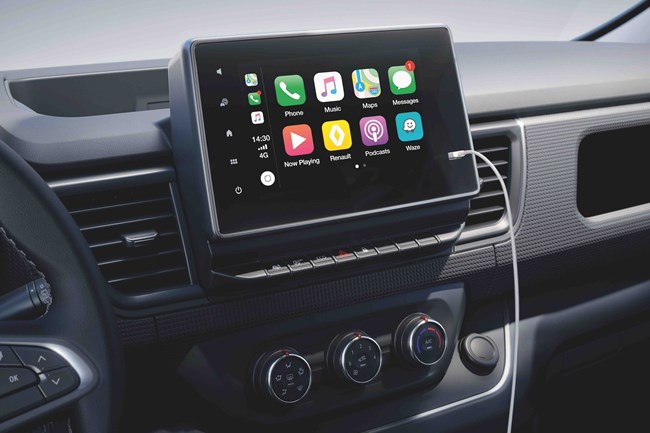- ETRUX launches new Ford E-Transit Trizone
- Renault gives UK debut to Master E-Tech at CV Show
- Isuzu D-Max long-term test – Latest Report
- Isuzu D-Max V-Cross Steel Edition revealed
- IVOTY Report: Stellantis explores the hydrogen proposition
- New Maxus EVs include eDeliver 5 van
- Used LCV values reach six-month high
- ADVERTISEMENT FEATURE: IVECO Daily Mission Awards 2024 Q2 Round-up: Grounds Maintenance & Forestry
- Stellantis Pro One electric vans review
- Mitie adds 5,000th EV to fleet
De-specced vans cause used market confusion
Date: Wednesday, March 1, 2023 | Author: Jack Carfrae
Supply shortages mean some new LCVs have been sold without key equipment, which could leave used buyers and sellers scratching their heads.

New vans sold with a reduced level of equipment due to ongoing supply chain shortages could cause confusion when they enter the used vehicle market.
What Van? has learned of at least one example of a major manufacturer selling a model without a key piece of kit and labelling it incorrectly, which would make it difficult to accurately identify and price second-hand.
“Renault, for example, went through a period with the Trafic Sport model – which comes with satnav, parking sensors, a reversing camera etc – coming out as a ‘Sport non-nav’,” said Andy Picton, chief commercial vehicle editor at Glass’s, “they couldn’t get satnavs – or they couldn’t get the parts for them, [and] Renault actually miscoded it as a non-nav model. It was only for a short period of time – maybe six months, at the most.”
Vehicle codes identify particular models and illustrate their minutiae. They are used extensively within the remarketing industry to highlight details such as trim levels and option packs.
“In the used market, it will still be called a Trafic Sport,” added Picton, “but unless your auction house describes it correctly… and unless you are in the know and you actually have a look in the vehicle for yourself, you are not going to know that some of them may come without the nav.”
Dylan Setterfield, head of forecast strategy at cap hpi, said such cases were rare. “It’s not in the normal process of what people do, so there is potential for people not to have registered vehicles correctly, although [those cases] will probably be few and far between.”
Picton suggested it was unlikely to have a significant impact on residual values because of the strength of the wider used van market.
“Values are strong, and I can’t see them coming back [down] at all for the foreseeable, because we’ve got that shortage of stock from three years ago when the pandemic started. That means we’ve got less vehicles coming back into the used market, and those vehicles that are coming back are harder worked, higher miles, older, poorer condition.”
Mark Jowsey, head of TCO at Auto Trader, backed up Picton’s assertion: “The market has been so starved of product that most of these reductions [in equipment] have had limited impact on forecast residual values.
“The reality is that the durability of the increase in RVs has meant that we’ve looked at stuff and said, ‘there is no justification for reducing the forecast for these missing items,’ because the market is continuing at an inflated level. And it’s all driven, really, by the sustained loss of production.”
Manufacturers have deliberately sold vehicles with reduced equipment amid ongoing supply shortages, although, unlike in Renault’s case, the listing for specifications and trim levels have typically been adjusted accordingly.
“It’s been very wide,” said Jowsey, “sometimes it’s been wrapped up as a [new] model year so that we would look at it as a new vehicle.”
Picton said manufacturers have given precedence to vans with less kit both because they are easier to build when parts are scarce and to meet demand from fleets, which often buy low-spec models and are desperate for new LCVs.
“They are trying to prioritise a lot of the fleet spec models because, obviously, those fleets need new vans [and] I guess it’s easier to supply a lower-spec vehicle than it is higher-spec ones.”
The greater issue for secondhand vans light on equipment is the confusion for dealers and their customers, because there is potential for similar models to appear on used forecourts with variable levels of kit.
“The typical thing in the trade will be to assume the lowest common dominator,” said Setterfield, “they will assume that it is the lowest level of equipment [if there is doubt about the trim level].”
“At the moment, you could have a situation where there are two vehicles [sold] a couple of months apart – or even the same week,” explained Jowsey. “You could end up with two vehicles with the same trim level but different equipment. That is where it starts to be tricky.”
“The biggest challenge is going to be for retailers ensuring that they communicate properly the specification of the individual vehicle. Three years/four years down the line, on a forecourt, if I want the same vehicle as you because you’re really happy with it and I like the look of it, I buy it, but it actually hasn’t got everything that yours has, that’s a problem. It has to be properly communicated by dealers.”
View The WhatVan Digital Edition


